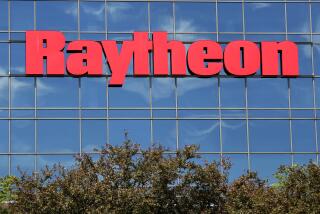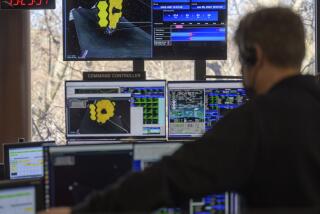4 Firms to Build Station in Space : McDonnell Douglas Unit to Add 1,000 Jobs in Huntington Beach
- Share via
NASA on Tuesday selected four aerospace contractors to design and build the U.S. manned space station, a project worth up to $30 billion that will create about 6,000 jobs in California and another 6,000 in six other states.
Two of the NASA awards went to prime contractors in Southern California: McDonnell Douglas Astronautics Co. in Huntington Beach and Rockwell International’s Rocketdyne Division in Canoga Park.
In addition, General Electric’s Astro-Space Division in Pennsylvania and Boeing’s Aerospace Co. in Huntsville, Ala., were chosen. All four prime contractors will use dozens of subcontractors to do about 50% of the work; many of those smaller firms are also in the Southland. Peak employment on the project is expected in about three years.
McDonnell Douglas officials said the contract will require the company to add at least 1,000 employees at the Huntington Beach facility in the next three years, bringing the total number of jobs there to as many as 10,000.
The new jobs will cover “the full spectrum” from manufacturing and semiskilled assembly work to engineering and design positions, officials said.
All of the manufacturing work under the McDonnell Douglas contract will take place at the Huntington Beach astronautics facility.
The space station will be assembled in orbit above the Earth in the mid-1990s after 19 flights by space shuttles to haul various parts into place. The station, which will be home to a crew of six to eight astronauts, will have living quarters, laboratories and work areas that will be attached to a 500-foot truss. It will be the largest structure ever put into space and is expected to be used for decades.
Although the National Aeronautics and Space Administration plans to issue preliminary contracts within two weeks, the space station faces an uncertain money future because of severe federal budget pressure.
“Our guess is that there will be enough (funds) to go ahead with these contracts, but we don’t really know,” NASA Administrator James C. Fletcher said in announcing the awards. “It took a little bit of courage on our part to go ahead.”
The space station program is expected to cost $14.6 billion to $30 billion, depending on whether the expense of shuttle flights is included. Those figures do not include the contractors’ profit or fees, which typically run 5% to 9% of the contract value.
In addition to congressional concern about the cost and risks of the space station, the National Research Council recently issued a scathing report that said the space station program is jeopardized by optimistic cost projections, management complexity and a shortage of future launch capacity. The program is likely to drain funds for other U.S. scientific space ventures, as well.
But NASA and industry officials Tuesday defended their cost estimates as being more conservative than earlier programs that often exceeded their projected cost and said that the complex management system designed for the station is needed for such a large undertaking.
The contractors selected Tuesday had bid for work totaling about $5 billion for a first phase of the station, plus $1.5 billion for a second phase that would include a significant enlargement of the station and its power source.
More Expensive Projects
That $6.5-billion total, split among dozens of companies, does not rank the space station among the largest aerospace projects, such as military aircraft programs, which have cost tens of billions. But the space station work will carry a unique and powerful prestige for companies that participate.
“If we want to have manned exploration of space anywhere beyond this planet, the space station is an absolute essential,” said Andy Stofan, NASA associate administrator for the space station.
“If this country wants to remain in space and remain in technological leadership . . . that’s what we can do with the space station. I cannot imagine this country walking away and turning space over to some other nation.”
Indeed, McDonnell Douglas officials were ebullient about their $1.9-billion contract to build the overall framework of the station and to provide many of the key operational systems, including propulsion, communications, navigation, control centers, air locks, a visual dome, thermal management and its mobile space crane.
“It is the heart and the soul of the space station,” said Bob Thompson, vice president and general manager for McDonnell’s Space Station Division in Huntington Beach. “I think this is the best work package of the lot.”
McDonnell officials said that, in addition to the new jobs at the Astronautics unit in Huntington Beach, 450 more jobs will be created at company facilities in Houston. About 50% of the value of its contracts will be subcontracted to other firms, including Lockheed Missiles & Space Co., Honeywell, IBM and RCA.
1,000 Rocketdyne Jobs
Rockwell International’s Rocketdyne Division will provide the solar panels, battery assemblies and power management system for the space station, at an estimated cost of $1.6 billion. Rocketdyne expects to have about 1,000 jobs on the space station program, said George W. Jeffs, Rockwell president of North American Space.
The company was unopposed in the competition after TRW dropped out early in the bidding. Jeffs termed the selection a “very substantial” new project for Rockwell.
But Rockwell was dealt a bitter blow in another area of the space station competition. The firm’s space station division in Downey lost the contract to build the framework to McDonnell Douglas, representing a major setback for a company that has been at the forefront of the U.S. manned space program. Jeffs said Rockwell will dissolve its space station division and relocate its 380 employees within the company.
General Electric was selected to provide a free-flying platform for scientific experiments, integration of a flight robotic servicer, information system activities and planning for a satellite service facility on the station. Its work is valued at $800 million.
Boeing will provide the laboratory and living quarters, logistics, air-lock systems, life-support systems, internal thermal systems, audio and video systems and various software. Its contract is valued at about $750 million, with $25 million more to come in the second phase.
Work Packages
Each of the four prime contractors is performing under what are called work packages that are managed out of four NASA centers around the country. NASA will act as the overall program integrator.
Lockheed Missiles & Space Co. in Sunnyvale, Santa Clara County, is not a prime contractor, but it is participating as a major subcontractor on three teams and came out of Tuesday’s selection process as a major winner. It is working with Boeing, Rockwell and McDonnell Douglas.
California, which won 50% of the jobs on the space station program, was virtually guaranteed to be a major winner in the space station program. In the largest work package, which is managed by Johnson Space Center near Houston, Rockwell and McDonnell Douglas both had planned to locate a major share of the work here.
More to Read
Inside the business of entertainment
The Wide Shot brings you news, analysis and insights on everything from streaming wars to production — and what it all means for the future.
You may occasionally receive promotional content from the Los Angeles Times.











